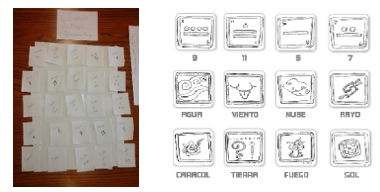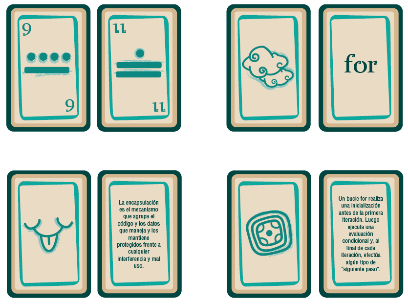Program with Ixquic
Program with Ixquic
Volume 2, Issue 3, Page No 918-921, 2017
Author’s Name: Carmen Ramos1, Tania Patiño2, a)
View Affiliations
1Department of Visualization and Virtual Reality, Ixtli, UNAM. National Autonomous University of Mexico, UNAM
2Circuito Exterior, Nº 3000, Ciudad Universitaria –Coyoacán, CDMX
a)Author to whom correspondence should be addressed. E-mail: taniapc@live.com.mx
Adv. Sci. Technol. Eng. Syst. J. 2(3), 918-921 (2017); ![]() DOI: 10.25046/aj0203115
DOI: 10.25046/aj0203115
Keywords: Story Telling, Serious Games, Game Design, Augmented Reality, Educative Games
Export Citations
The goal of this paper is to explain the story telling, game design, game play and how is the interaction with the game Program with Ixquic. Here is the description about the new approach to this video game I called Program with Ixquic. Initially focused on an educational video game but now is a hybrid, now has more levels and provides moments of great fun, where each player can have some much fun in each different level and environments of interaction.
Received: 17 April 2017, Accepted: 19 May 2017, Published Online: 30 June 2017
1. Introduction
In this article we consider pertinent to ask the following question from which we set out to create this video game. How can you learn to program in object-oriented philosophy with languages such as Java?. To answer this question is that we created a video game that allows players to learn languages such as Java. This video game we call Program with Ixquic and we started to create it from the year 2014, conceptualizing and generating ideas, that would allow us to create what we now have a complete and very fun game. Program with Ixquic.
Program with Ixquic, is a game that started as an educational game to learn object oriented programming in Java language. After some changes now it’s an entertainment game with a bit of the topic of education. Program with Ixquic, contains three game levels, consisting of a card game, hidden objects and a 3D environment, in Augmented Reality like a fairy tale, where the player can interact and play in different ways to learn some programming.
Fortunately this game has evolved and with this improved remarkably. In this article we show an advance of this development that has been changing over time from being a simple 2D card game to a small pandora box full of incredible surprises that each player will enjoy to the maximum.
Program with Ixquic, is a game (in the future a complete Serious Game) that contains some ingredients related to training applications, application that improving cognitive functions, memory training, development of mental skills and improvement of strategic skills.
However, there are many applications that are directed to control sensors to calculate heart rate, moods and is applied in either sensory, psychological or motor rehabilitation of the users [8].
2. Serious Games
2.1 How to define a Serious Games
“Serious Games are a mental contest, played with a computer in accordance with specific rules, that uses entertainment to further government or corporate training, education, health, public policy, and strategic communication objectives. [9]”
2.2 What are the objectives of SG?
SGs seek to improve a particular skill of the user interacting with the game. The idea is that while the player interacts more and more with the game will improve some cognitive, sensory or physical ability [9].
3. Story Telling Program with Ixquic
This is the story that starts this video game Program with Ixquic, described in a comic that tells the story of a girl named Cucita who is one of the characters of Program with Ixquic. The story begins in the CDMX in the traffic of a sunny day and Cucita in a moment of thinking about the immortality of the crab, in traffic imagine that it would be a good idea to create a programming application to learn to program in some language programming in basic form. This is the intro of Program with Ixquic and from there starts this video game [2], [7],[8].
 Figure.1. Story Telling Program with Ixquic
Figure.1. Story Telling Program with Ixquic
4. Game play of Program with Ixquic
Program with Ixquic, consists of a card game, hidden objects and a 3D environment in Augmented Reality with expanded object display, where the player can interact and play in different ways by learning some programming.
To enter the game appears this interface of Program with Ixquic:
 Figure.2. Interface Program with Ixquic [2].
Figure.2. Interface Program with Ixquic [2].
4.1 User-Centered Design in Program with Ixquic
This is an example of how we were creating each level of play, for example, is the card game level, we first generated it with paper and pencil. We tested user to see if it worked and how it worked. Once we have finished, we begin with the design of each letter and each symbol representing an element of nature, a number or a Mayan symbol. This is an application where is involved the user in each phase of the development process which ensures that the final product responds to their needs and characteristics [10]. Then this is the result of the level 1 of the video game Program with Ixquic.
 Figure.3.User-Centered Design in Program with Ixquic
Figure.3.User-Centered Design in Program with Ixquic
4.2. Level 1. Card Game
A Card Game, was where we applying the design philosophy and a process related to User-Centered Design (DCU) [10], we understand the requirements and limitations of the end user then we create this type of card game that had magical symbols where we expected that the users can learn and practice in an original way topics related to programming.
This card games comes from ancient times and distinct places in the world: Egypt, India and China. In this case each card has a description of a data structure or a programming concept, thus giving a description of its function[1].
 Figure.4. Basic programming concepts
Figure.4. Basic programming concepts
4.3 Level 2 Hidden Figures
In this level called Hidden Figures, we show a landscape where each user have to find (photographs, drawings, graphs, etc.), that are hidden and have to be found. Those things are related to programming concepts or structures, maybe a question is done and then find the thing.
Here is an example of a landscape Yucatán, México, where an investigator have to find many things related to programming topics of Java [6].
4.4 Level 4 Augmented Reality
The third level in Program with Ixquic is a 3D environment in Augmented Reality with expanded object display. The concept of Augmented Reality brings together a wide variety of user experiences. There are three main categories of RA tools [4],[5].
– Augmented reality games generate immersion experiences.
– Augmented reality 3D visualizer, as it is the case of Augment, allows to place 3D models in real size in the environment, using a ‘tracker’ to move the model in space.
– Augmented reality browsers enrich the camera viewer with context information. For example, one can point his or her smartphone at a building to visualize a story.
In Program with Ixquic, we create a story tale and some interactions with characters in augmented reality technology (RA), and a book with scenarios come to life, allowing gamers to interact with them and experience stories that are told in a more engaging way. This books only need an Internet connection, a camera (it can be a smartphone, a tablet or laptop) to display the tale [2],[3],[4].

 Figure.6. AR Ixquic Princess Tale
Figure.6. AR Ixquic Princess Tale
Conflict of Interest
The authors declare no conflict of interest.
Acknowledgment
We thank all the team and friends at the National Autonomous University of Mexico, UNAM, specially the Department of Visualization and Virtual Reality, Ixtli, UNAM. Where the development of this Serious Game: Program with Ixquic, started.
Continuing with the creation of Program with Ixquic, all the Game Design, Programming levels and Game tests were made at my studio called Madagascar Computer Games and Systems S.A. de C.V. This paper is dedicated to my dear friend Israel Figueroa Angulo.
- Patino, T., and Ramos, C., “Program with Ixquic: How to Learn Object-Oriented Programming with a Game,” 2015 7th International Conference on Games and Virtual Worlds for Serious Applications (VS-Games), Skövde, 2015, pp. 1-2. doi: 10.1109/VS-GAMES.2015.7295781
- Pelletier, C. “Producing difference in studying and making computer games: How students construct games as gendered in order to construct themselves as gendered,” in Y. B. Kafai, C. Heeter, J. Denner, & J.Sun (Eds.). Beyond Barbie and Mortal Kombat: New Perspectives on Gender and Games (Cambridge MA, 2006), MIT Press.
- McGonigal J. All Game Play is Performance: The State of the Art Game University of California @Berkeley/42 Entertainment. (www.avantgame.com). May 13, 2005.
- D.Wagner and D. Schmalstieg, “Making Augmented Reality Practical on Mobile Phones, Part 1,” in IEEE Computer Graphics and Applications, vol. 29, no. 3, pp. 12-15, May-June 2009.doi: 10.1109/MCG.2009.46
Conference Papers: - Ramos C., and Patino, T., “Program with Ixquic: Educative Games and Learning in Augmented and Virtual Environments,” 2016 8th International Conference on Games and Virtual Worlds for Serious Applications (VS-GAMES), Barcelona, 2016, pp. 1-2. doi: 10.1109/VS-GAMES.2016.7590359
- Solís A., Patino T., and Radillo J., Improving Cognitive Abilities with Gaming Concepts in Computer Graphics and Videogames courses. Proceedings of the 2007 DiGRA International Conference: Situated Play, DiGRA 2007, Tokyo, Japan, September 24-28, 2007. Digital Games Research Association 2007.
Books: - Kushner, D. Masters of Doom: How Two Guys Created an Empire and Transformed Pop Culture. May 11, 2004.
- McGonigal J. SuperBetter: A Revolutionary Approach to Getting Stronger, Happier, Braver and More Resilient Powered by the Science of Games. September 15, 2015.
- Michael D., Chen S.,”Serious Games: Games That Educate, Train, and Inform”. Muska & Lipman/Premier-Trade ©2005. ISBN:1592006221
- Shneiderman, B. (1998). Designing the user interface: Strategies for effective human-computer interaction(3rd ed.). Reading, MA: Addison-Wesley.


